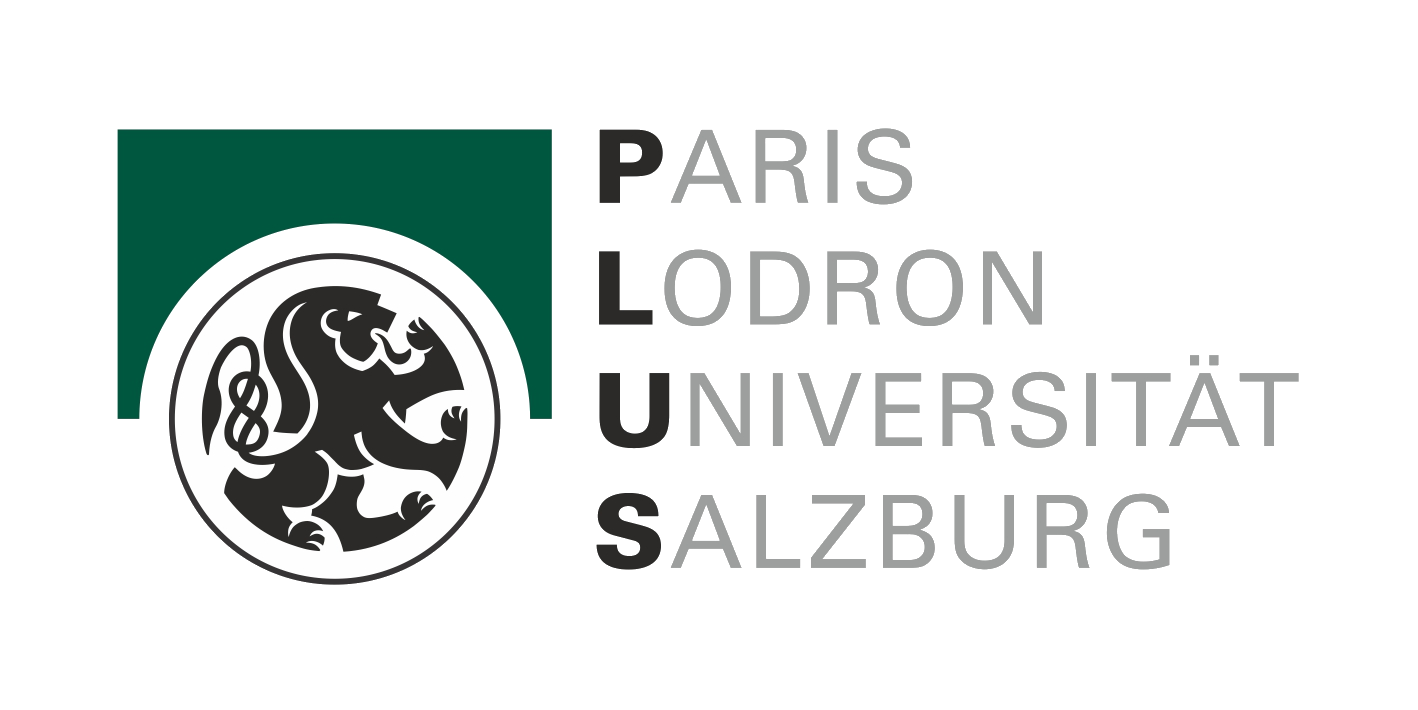History of “Hanslick Online”
Alexander Wilfing, 2025
“Hanslick Online” emerged from research projects conducted by Christoph Landerer and Alexander Wilfing at the Austrian Academy of Sciences beginning in 2017. These projects were initially housed at the Institute of History of Art and Musicology (2014–2019) and, in 2020, moved to the Austrian Centre for Digital Humanities, Department of Musicology (ACDH). Their research focuses on Hanslick’s historically significant treatise Vom Musikalisch-Schönen: Ein Beitrag zur Revision der Aesthetik der Tonkunst (Leipzig: Rudolph Weigel, 1854; On the Musically Beautiful: A Contribution to the Revision of the Aesthetics of Music)—which during Hanslick’s lifetime appeared in ten revised editions—Hanslick’s activities as a music critic, and his professorship in the “History and Aesthetics of Musical Art” in Vienna, the earliest such position in German-language academia. Landerer has examined Hanslick’s aesthetics repeatedly since about 1990: his first study on the topic, “Bernard Bolzano, Eduard Hanslick und die Geschichte des musikästhetischen Objektivismus,” was already published in 1993 in Kriterion (no. 5 and no. 6), and in 2001–2003 he visited the University of Toronto on an Erwin Schrödinger Fellowship (J1995 / J2161), conducting the research project “Eduard Hanslick’s Musical Aesthetics in the Context of Austrian Intellectual History” with Geoffrey Payzant, who had translated Vom Musikalisch-Schönen into English in 1986 as On the Musically Beautiful. Wilfing’s research has dealt with Hanslick since preparing his dissertation Eduard Hanslicks Rezeption im englischen Sprachraum (completed in 2016 and published in 2019 as Re-Reading Hanslick’s Aesthetics), which explores his aesthetics as well as his impact on various disciplinary discourses, ranging from musicology and music philosophy to music psychology, literary theory, art history, and musical criticism. Moreover, he directed the project Creating an Academic Discipline: Eduard Hanslick, Guido Adler, and the Establishment of Musicological Methodology in 19th-Century Vienna (Erwin Schrödinger Fellowship J4529) from 2021 to 2023—conducted at the Max Planck Institute for Empirical Aesthetics (Frankfurt a.M.), Masarykova Univerzita (Brno), and the ACDH—which (among other things) investigated Hanslick’s professorship, and has recently been analyzing Hanslick’s critical writings. The overall project series, which explores the historical background of Hanslick’s activities as an aesthetic theorist, music critic, and musicologist, consists—as of 2025—of the following individual research projects, for which Landerer and Wilfing have received support from various funding bodies:
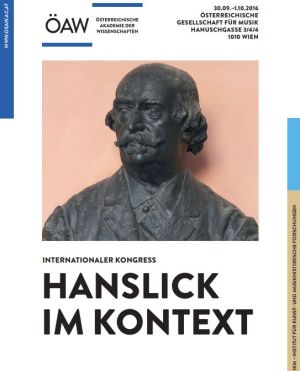 Program of the conference “Hanslick im Kontext,” photograph by Franz Pflügl; by
courtesy of the University of Vienna
Program of the conference “Hanslick im Kontext,” photograph by Franz Pflügl; by
courtesy of the University of Vienna
- 2014–2017, Hanslick in Context: Hanslick’s Aesthetic Ideas, Their Genesis, and Their Place in the History of Ideas (stand-alone project, funded by the Austrian Science Fund FWF, P26610, P.I. Christoph Landerer)
- 2017–2018, Studies in the Genesis of Hanslick’s Vom Musikalisch-Schönen: Textual and Contextual Analysis (stand-alone project, funded by the Anniversary Fund of the Austrian Central Bank, 17508, P.I. Christoph Landerer)
- 2018–2021, Eduard Hanslick’s Vom Musikalisch-Schönen: An Analysis of the Dynamic Features of the Text and Its Contexts (stand-alone project, funded by the Austrian Science Fund FWF, P30554, P.I. Christoph Landerer)
- 2021–2023, Creating an Academic Discipline: Eduard Hanslick, Guido Adler, and the Establishment of Musicological Methodology in 19th-Century Vienna (Erwin Schrödinger Fellowship, funded by the Austrian Science Fund FWF, J4529, P.I. Alexander Wilfing)
- 2022–2026, Eduard Hanslick’s Criticism Between Aesthetics, Journalism, and Scholarship (stand-alone project, funded by the Austrian Science Fund FWF, P35379, P.I. Alexander Wilfing)
- 2024–2025, The Critic Under Scrutiny: The Reviews of Eduard Hanslick’s On the Musically Beautiful (1854–1857) (stand-alone project, funded by the City of Vienna, P.I. Alexander Wilfing)
- 2025–2027, Vom Musikalisch-Schönen: Reconstructing Hanslick’ Aesthetics Analytically (stand-alone project, funded by the Austrian Science Fund FWF, PAT2049024, P.I. Alexander Wilfing)
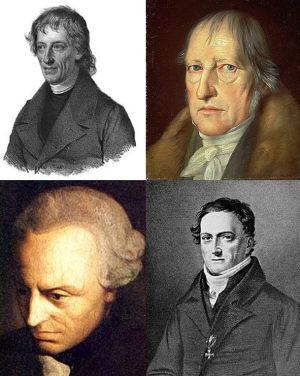 Collage of images of Bolzano, Hegel, Herbart, and Kant (Wikipedia Creative Commons)
Collage of images of Bolzano, Hegel, Herbart, and Kant (Wikipedia Creative Commons)
“Hanslick in Context,” presenting the foundation for ensuing research ventures, aimed at critically analyzing the “eclectic” intellectual background of Hanslick’s aesthetics, the genetic factors of which were made transparent from an overarching perspective. Here, we focused on grasping Hanslick’s method of selectively integrating different philosophical discourses as well as his use of textual sources, thereby providing a stable basis for Hanslick scholarship, which has reached strikingly disparate findings in assessing the historical background of Vom Musikalisch-Schönen. In a first step, we took into account various positions in nineteenth-century aesthetic discourse, whose respective relevance for Hanslick’s reasoning had for the most part been scrutinized separately. In consideration of our hypothesis that Hanslick’s treatise cannot be assigned to any individual philosophical movement and that it is of a quasi-hybrid nature, we analyzed the various sources of his remarks and methods in a broad fashion. In addition to philosophers prominent in Hanslick literature—e.g. Bolzano, Hegel, Herbart, Kant, Vischer, and Zimmermann—we integrated lesser-known figures such as Gutt, Hand, Michaelis, Nägeli, and Weisse into this discursive formation. We moreover examined the parameters of Habsburg education policy and its influence on Hanslick’s aesthetics, which evolved in intimate contact with the Austrian Ministry of Education—led by Count von Thun und Hohenstein—the empirical-formalistic orientation of which also shaped some of his primary doctrines. In addition to Hanslick’s contacts with central figures of the Thun reform, we analyzed the genetic aspects of his aesthetic position. Besides content-related factors, this included questions concerning methodology, e.g. Hanslick’s juridical training and the scientific-theoretical orientation of Austria. In this vein, we were able to integrate established intellectual-historical research methods with current trends towards a broader historical contextualization of Hanslick’s Vom Musikalisch-Schönen, consequently demonstrating how the genetic context of this book illuminates the intellectual foundations of Hanslick’s aesthetics. We thus made clear how the complex and neglected interplay between philosophical orientations, specific aesthetic traditions, institutional and political settings, and personal relations affected Hanslick’s positions, which did not mature in post-1848 Vienna by historical accident. It is only against this diversified background that one can hope to grasp the peculiarities of an aesthetic approach which otherwise defies proper classification in terms of intellectual coordinates and was devised in a wide field of tension between philosophical, aesthetic, political, scientific, and juridical discourses.
The project “Studies in the Genesis of Hanslick’s Vom Musikalisch-Schönen” continued this work along these lines and expanded our research approach by including the dimension of the historical evolution of the book itself, which was now investigated from a more systematic perspective. Vom Musikalisch-Schönen was now considered a dynamic textual corpus, which permits claims regarding “the” aesthetics of Eduard Hanslick solely on basis of detailed genetic studies. The genetic and historical dimension of the text was analyzed carefully as regards the emergence of this book from pre-publications of 1853 and 1854 (chapters 4, 5, and 6), the chronological as well as logical order of the seven chapters, and the crucial changes in the new editions of 1858 (2nd edition) and 1865 (3rd edition), which are also important regarding Hanslick’s reception in aesthetic discourse. Vom Musikalisch-Schönen thus appears neither as an “aphoristic” collection of older texts, nor as a purposefully straightforward monograph, but as a text with a complex argumentative structure, which can only be grasped by means of specific genetic analyses. Our reconstruction of the chronological and logical fabric of Vom Musikalisch-Schönen revealed a surprising chapter sequence (6, 4, 5, 1, 2, 3, 7) that contradicts the familiar sequence of published chapters. We combined this textual problem with the continued examination of relevant contexts, which might have caused the corresponding textual changes and ongoing variation of Hanslick’s arguments in a direct manner. Here, we also focused on Hanslick’s political contexts and institutional affiliations, which proved crucial for the realization of his academic career strategy. Apart from these contextual and textual studies, we moreover included empirical documents (letters, files, etc.), which provided an additional methodological dimension and added depth to our research findings. These (unfortunately rather sparse) documents were furthermore supplemented by a detailed analysis of Hanslick’s personal contacts with prominent nineteenth-century aesthetic theorists (e.g. Robert Zimmermann) and the overall political situation in Vienna; on that front, we considered Hanslick’s activities at Count Thun’s Ministry of Education and its positivistic orientation to be of particular relevance. Such contexts also illuminated significant modifications in edition 2 of Vom Musikalisch-Schönen, which retracts remnants of Romantic aesthetics and reinforces its formalistic orientation.
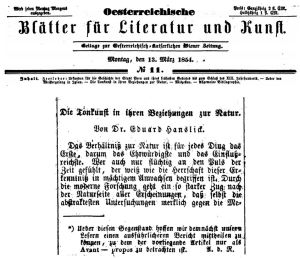 The eventual chapter no. 6, “Die Tonkunst in ihren Beziehungen zur Natur”
The eventual chapter no. 6, “Die Tonkunst in ihren Beziehungen zur Natur”
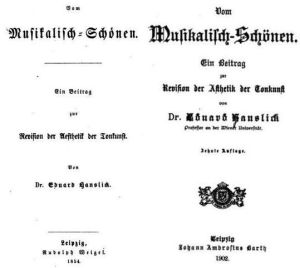 Vom Musikalisch-Schönen, edition 1 (1854) and edition 10 (1902)
Vom Musikalisch-Schönen, edition 1 (1854) and edition 10 (1902)
The project “Eduard Hanslick’s Vom Musikalisch-Schönen: An Analysis of the Dynamic Features of the Text and Its Contexts” resumed our treatment of Hanslick’s aesthetic treatise as a dynamic corpus of textual material, while significantly expanding our respective investigation. The period of analysis now covered the years 1848 to 1902 and thereby included all ten versions of Vom Musikalisch-Schönen that were edited by Hanslick during his lifetime, as well as the evolution of his arguments in preliminary publications and remarks on the themes of his aesthetic treatise in his musical criticism and other textual formats. This substantial expansion of the time frame of our investigation also corresponded to a newly developed and much more comprehensive understanding of the central contexts. We now proceeded to distinguish between the theoretical contexts of Vom Musikalisch-Schönen and its stages of continuous development (essential theoretical discourses in a broad sense with the core areas of philosophy, science, music theory) and the practical contexts of this book (political setting, institutional affiliations, personal networks). Said theoretical contextual fields were examined in great detail both at the intradiscursive level (development of the individual discursive formations) and the interdiscursive level (interaction of the discursive formations with each other). The specific analyses covered three areas: (a) the historical evolution of Hanslick’s arguments from approx. 1848 to the initial edition of 1854, (b) the genesis, layout, and structure of the arguments within the wording of edition 1 and primarily the conceptual development of central notions within the chapters, and (c) Hanslick’s variation of essential arguments in later editions, up to edition 10 of 1902. This approach was moreover intended to replace a rather static understanding of Hanslick’s aesthetics with a dynamic reading, capable of illuminating how elementary references, ideas, and terms are transformed continuously from the individual perspective of Hanslick’s various editions. This very “dynamization” of Vom Musikalisch-Schönen contributed significantly to a fuller grasp and more appropriate understanding of this essential aesthetic treatise, the historical reception of which frequently overlooks how the dynamic properties of contexts and text(s) deeply affect our interpretation of Hanslick’s concepts and methods.
The project “Eduard Hanslick’s Criticism Between Aesthetics, Journalism, and Scholarship” now shifts the focus of our ongoing research to Hanslick’s critical writings, while retaining our attention to questions of textual analysis. While scholarship has so far focused chiefly on analyzing and interpreting Hanslick’s aesthetics and situating his theoretical reasoning in the context of his age, the current project explores the relation between the various textual genres of his oeuvre, which remains unclear to this very day. For if in Vom Musikalisch-Schönen, for example, Hanslick casts doubt on the frequently postulated correlation between emotion and music from an aesthetic perspective, his critical articles are interspersed with expressive metaphors that at first glance conflict with the maxims of his treatise. Other supposed deviations most likely result from the fact that Hanslick’s activities as a music critic spanned some sixty years (1844–1904) and developed dynamically over time, while his aesthetic treatise—which he usually altered only slightly in later revised editions—remained relatively static. The project thus explores the dynamics of these fluid processes and analyzes to what extent Hanslick’s critical writings are compatible with Vom Musikalisch-Schönen, whether genuine contradictions arise, or whether later texts can even be read as an elaboration of his aesthetic approach, which has failed to sufficiently theorize essential questions such as the performative nature of music. Here, the project will furthermore reconstruct Hanslick’s criteria for selecting and editing certain essays for the (sometimes thoroughly modified) textual versions provided in his various anthologies, thereby seeking clarification about shifts in Hanslick’s positions. Moreover, as he conceived of these collected volumes as a “living history” of music in Vienna, they will be cross-read with Hanslick’s conception of academic musical research. This view will then be extended to Hanslick’s concrete language use (expression, speech figures, metaphors, etc.), opening the project to an analysis of cultural, political, and general historical contexts as well as their shifts over time, which will become the focal point of a follow-up project. The textual analysis is based on the digital edition of Vom Musikalisch-Schönen (2023) and the transcription / TEI annotation of Hanslick’s writings for the Neue Freie Presse (1864–1904) and his 12 anthologies, which are being put online in an ongoing process.
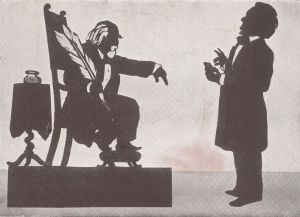 Eduard Hanslick and Richard Wagner, silhouette by Otto Böhler; by courtesy
of Österreichische
Nationalbibliothek
Eduard Hanslick and Richard Wagner, silhouette by Otto Böhler; by courtesy
of Österreichische
Nationalbibliothek
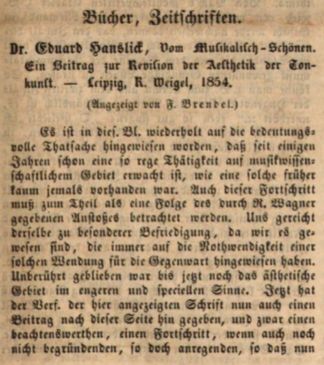 Franz Brendel, review of Vom Musikalisch-Schönen, Neue Zeitschrift für Musik, February 16, 1855
Franz Brendel, review of Vom Musikalisch-Schönen, Neue Zeitschrift für Musik, February 16, 1855
The project „The Critic under Scrutiny: The Reviews of Eduard Hanslick’s Vom Musikalisch-Schönen (1854–1857)“ takes a closer look at the development of Vom Musikalisch-Schönen by examining reviews of the initial edition as a catalyst for changes in Hanslick’s argument. Alongside the more widely known reviews by Robert Zimmermann and Hermann Lotze, 26 reviews appeared between the end of 1854 and the end of 1857, when the second edition of Hanslick’s treatise was published. Pertinent examples include a four-part review by Ludwig Bischoff (Niederrheinische Musik-Zeitung, February 17, February 24, March 3, and March 10, 1855), a three-part review by Franz Brendel (Neue Zeitschrift für Musik, February 16, February 23, and March 2, 1855), as well as a review in Dwight’s Journal of Music (July 21, 1855). The project team will process these reviews as annotated XML/TEI files and make them available as a distinct textual corpus. Beyond this edition, we will also analyze the extent to which Hanslick explicitly addressed or implicitly responded to criticism, and whether he borrowed passages from these reviews in ensuing editions. This project on the earliest reviews of Vom Musikalisch-Schönen thus not only enriches our understanding of Hanslick’s reception and the aesthetic and musical debates of the nineteenth century; it moreover contributes to the reconstruction of the emergence and development of a text that remains central to music philosophy today.
The project “Vom Musikalisch-Schönen: Reconstructing Hanslick’ Aesthetics Analytically” returns directly to Hanslick’s aesthetic treatise On the Musically Beautiful, which continues to represent one of the most influential and debated treatises in the history of musical aesthetics. Published in the mid-nineteenth century, this seminal work garnered international attention, influencing the discourse of major philosophers of music and aesthetic thinkers. Despite its impact, interpretations of Hanslick’s arguments remain strikingly diverse and often contradictory, leading to what Nicholas Cook aptly termed “the most-talked-about and least-understood essay on the true nature of music.” This research project aims to offer a groundbreaking analytical reconstruction of Hanslick’s treatise, tackling longstanding issues surrounding its complex structure and elusive argumentation. The treatise’s non-linear composition—where chapters and ideas unfold in an order distinct from their presentation—has perpetuated misinterpretations, particularly in distinguishing Hanslick’s views on musical form(s) and emotional expression. Through meticulous textual analysis, we will deconstruct the book’s logical fabric, examining its structure to reveal the intricate interplay of Hanslick’s arguments. Central to this project is an innovative, dual-level approach. At the micro-level, we scrutinize key concepts and their contextual evolution within chapters, uncovering how Hanslick reused and refined arguments across various editions. At the macro-level, we trace the overarching trajectory of the treatise, exploring its genesis and development throughout the book’s chapters and editions. This combined approach will clarify Hanslick’s nuanced positions on topics such as music’s expressive properties, its formal qualities, and the role of performance, without explaining away ambiguities presented by Hanslick’s arguments. The project will also leverage cutting-edge digital humanities tools enhancing “Hanslick Online” through a detailed textual commentary, visualization tools, timeline diagrams, and semantic search capabilities. These features promise to facilitate a nuanced and historically informed perspective that also bridges the gap between German- and English-language discourses. By shining new light on Hanslick’s arguments in their full complexity, we hope to reinvigorate Hanslick scholarship but also to enhance current debates in the aesthetics and philosophy of music.
 An example of argument analysis in Robert J. Yanal, “Hanslick’s Third
Thesis,” British
Journal of Aesthetics, 46, no. 3 (2006): 259–266
An example of argument analysis in Robert J. Yanal, “Hanslick’s Third
Thesis,” British
Journal of Aesthetics, 46, no. 3 (2006): 259–266
The majority of projects were supported by numerous “international collaborators,” for whose assistance and dedicated cooperation we thoroughly appreciate. These collaborations included the following partnerships:
- Hanslick in Context: Hanslick’s Aesthetic Ideas, Their Genesis, and Their Place in the History of Ideas: Mark Evan Bonds (University of North Carolina at Chapell Hill), Stephen Davies (University of Auckland), Lydia Goehr (Columbia University in the City of New York), Thomas S. Grey (Stanford University), Nicole Grimes (University College Dublin), Lee Rothfarb (University of California, Santa Barbara), and Nick Zangwill (University College London).
- Studies in the Genesis of Hanslick’s Vom Musikalisch-Schönen: Textual and Contextual Analysis: Mark Evan Bonds (University of North Carolina at Chapell Hill), Lee Rothfarb (University of California, Santa Barbara), and Nick Zangwill (University College London).
- Eduard Hanslick’s Vom Musikalisch-Schönen: An Analysis of the Dynamic Features of the Text and Its Contexts: Mark Evan Bonds (University of North Carolina at Chapell Hill), Bojan Bujic (University of Oxford), Thomas S. Grey (Stanford University), Hans-Joachim Hinrichsen (Universität Zürich), Lee Rothfarb (University of California, Santa Barbara), Dietmar Strauß (Schwalbach, Germany), and Nick Zangwill (University College London).
- Eduard Hanslick’s Criticism Between Aesthetics, Journalism, and Scholarship: Thomas S. Grey (Stanford University), Nina Noeske (Hochschule für Musik und Theater Hamburg / Hochschule für Musik Franz Liszt Weimar), Anthony Pryer (Goldsmiths, University of London), Lee Rothfarb (University of California, Santa Barbara), and Lawrence Zbikowski (University of Chicago).
- Vom Musikalisch-Schönen: Reconstructing Hanslick’ Aesthetics Analytically: Hanne Appelqvist (University of Helsinki), Lee Rothfarb (University of California, Santa Barbara), Tiago Sousa (Universidade do Minho), Sanja Srećković (Ruhr-Universität Bochum), and Nick Zangwill (University College London).



